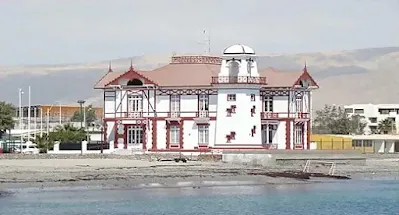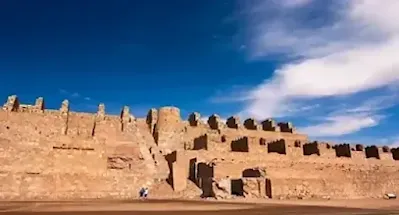Chile News and Travel| By Raul Silva M.
Antofagasta, the capital of the region of the same name, also known as the "Second Region of Chile", is a port city with 361,000 inhabitants in its urban area,, making it the fifth most populous city in Chile according to the 2017 census. The distance from Santiago is 1368 km.
From an economic point of view, a significant part of its primary industries are related to the considerable growth of the mining sector. Antofagasta is often referred to as the "Pearl of the North" due to the vast mineral resources that cover the entire region and its status as one of the most important cities in Chile. It is important to note that historically, the city was originally part of Bolivia, and following the 1904 Treaty of Peace and Friendship, Antofagasta was incorporated into Chile.
Its landscape is defined by the vastness of the Pacific Ocean and the immensity of the Atacama Desert, the driest in the world. Today, the regional economy is primarily driven by the extraction of various minerals, particularly copper and lithium, with some of the largest deposits in the world. Additionally, the region hosts a record number of photovoltaic, solar thermal, and green hydrogen projects, some of which are already operational, while others are in the early stages of development.
How to get there
- By Land: There is good road connectivity with numerous bus lines departing from Santiago and other nearby cities. The road system called "Autopistas de Antofagasta" covering the entire Region, is composed of Route 5 North (Pan-American Highway), Route 1, Route 26 and Route B 400.
- By Plane: Andrés Sabella Galvez International Airport is located 24 Km. North of the city. Daily flights connect the airport with Santiago, Calama, La Serena, and Iquique. "La Perla del Norte" is full of interesting places, here are the main tourist attractions in Antofagasta:
La Portada Natural Monument
La Portada (The Gateway), is one of the most popular postcards in Chile and is located 18 km north of Antofagasta via Route 1 and then a 2 km fork corresponding to Route B-446.
It is a natural rock formation in the shape of an arch, created by the erosive action of the sea on the coast, surrounded by 70-meter high cliffs. The arch itself is 43 m high, 23 m wide and 70 m long and is located very close to the coast. The base, which is made of volcanic rock, is about 150 million years old, while the arch, which is made of sedimentary rock, is 2 million years old. It is worth noting that the geological formation is very similar to the already collapsed Darwin's Arch in the Galapagos Islands.
From the viewpoint you can enjoy the vastness of the ocean, as well as a wide variety of birds and marine fauna. However, due to the aridity of the area, the flora is practically non-existent.
Plaza Colon
Plaza Colon (or Plaza de Armas) is one of the most representative places of Antofagasta. It is the main square of the city, a site full of history because it witnessed the landing of the Chilean troops in 1879 and keeps symbols of the foreign colonies that founded the region.
One of them is the Clock Tower donated by the British Colony, installed in 1911 in the center of the square, in commemoration of the first centenary of the Independence of Chile. The monument was originally planned as a scale model of the Tower of the Houses of Parliament in Westminster, but the rules that regulated the constructions of that time prevented the total achievement of the primitive project (it was expressly forbidden that there was any construction that would exceed the Cathedral in height). Its chimes evoke the original Big Ben.
Another of the symbols is the Kiosko de Retretas, also inaugurated in 1911, donated by the Croatian Colony in return for the friendship and affection of the native residents. There, every weekend, there were presentations of folkloric groups or military bands. At present, after having suffered serious damage by a strong earthquake in 2007, the Kiosko de Retretas was fully restored. It is worth mentioning that just like in the southern end of the country, this region received an important wave of Croatian immigrants, especially in the early 19th century.
The statue to Spain and America, donated by the resident Spanish community, represented by two female images at the top of the sculpture. A condor with the Chilean coat of arms and a lion with the Spanish emblem complete the set.
Ruinas de Huanchaca
Visiting the imposing stone structure of the Huanchaca Ruins for the first time is truly impressive, as it looks like an abandoned fortress of an extinct culture. But in reality, this National Historical Monument, the oldest structure in the city, dating back to 1888, is what remains of an old silver foundry that belonged to a former Bolivian mining company.
The foundry closed its doors for good in 1902, and more than 60 years passed before the facilities were transferred by the Chilean government to the Universidad Catolica del Norte. In 1974, Huanchaca was declared a National Historic Monument. In 2007, with the creation of the Fundacion Ruinas de Huanchaca, made up of the Universidad Catolica del Norte in partnership with Enjoy Antofagasta, the monument was officially included in a plan that considered its openness to the people. Today, the ruins are located in the Parque Cultural Huanchaca, located at 01606 Angamos Avenue, in front of the Enjoy Antofagasta Casino, a park that also includes the Museo Desierto de Atacama, with astronomical, geological and archaeological exhibits, a great cultural and tourist center of the Antofagasta region.
Museo Regional de Antofagasta
The non-profit institution Museo de Antofagasta, is a historical, archaeological and geological gallery located at 2786, Jose Manuel Balmaceda Av., in the historic district of the city. It was created in 1964 under the auspices of the former Universidad del Norte and then transferred to the Direccion de Bibliotecas, Archivos y Museos de Chile in 1984. Today, the museum has 12 permanent rooms and an auditorium for temporary exhibitions, distributed in two buildings that formerly belonged to the customs and maritime authorities. The collection, grouped in the areas of bioanthropology, natural and social sciences, has about ten thousand cultural objects, including mineral, paleontological and archaeological samples related to the pre-Hispanic cultures of the desert coast.
Museo Regional de Antofagasta
The museum also has an important photographic collection of about 1,500 images representing different aspects of Antofagasta society in the mid-20th century. In addition, there are ethnographic components, works of art, objects and historical documents related to the urban and mining history of the Antofagasta region, especially furniture and an endless number of tools related to the daily life and tasks of the once flourishing nitrate fields.
Other places that promote culture in Antofagasta are the Regional Library, located at 2623 George Washington St., in the heart of the city; the Municipal Theater, located at 433 Jose Antonio de Sucre St.; the Andres Sabella Cultural House, located at 2535 Juan Jose Latorre St.
Balneario Municipal
Balneario Municipal is very popular, the first artificial beach of Antofagasta. With 130 mts. long, it is located in the southern part of the city, suitable for swimming and all the activities related to the marine environment, there is a floating raft with capacity for 50 people in the middle of the sea, with a surface of 100 mt.2 and a resistance of 32 tons. It is surrounded by green areas, restaurants and places of entertainment.
The city has a rocky coastline, so this is one of the few beaches within the city limits. Other beaches suitable for swimming in Antofagasta are El Trocadero, Paraiso, La Chimba (Antofagasta's fourth artificial beach, scheduled to open in 2025) and outside the city limits is Balneario Juan Lopez, known for its beautiful sandy beaches, clear blue waters and stunning coastal views.
Visitors can enjoy a variety of water activities such as swimming, sunbathing, beach sports and amenities that include restaurants, cafes and picnic areas. There is also Playa Las Losas, a beautiful 1.4 km long beach with volcanic rock formations that make it a stunning natural attraction. The beach is known for its soft white sand and unique rock formations, making it one of the most beautiful beaches in the city. Located between La Portada and Playa La Rinconada, it offers visitors a picturesque coastal experience.
Mercado Municipal
Address: 776, Maipu Street, in front of the Sotomayor Square, one of the emblematic places of the city. Antofagasta's central market was an old railway station and plaza, and since 1927 it has been one of the tourist attractions with the most traditional gastronomic products of the northern city.
It also stands out for its elegant neoclassical building, which makes it one of the most beautiful markets in the country.
Old railway station Antofagasta-Bolivia
From Plaza Colón, walking along Simón Bolívar Street towards the coast, an old building with green walls, wooden windows and balconies appears on the right. It is the old station of the Antofagasta to Bolivia Railroad (FCAB), built in 1888.
In 1981, the building, platforms and administrative offices were declared a National Monument in the category of Historical Monument. Today the building is still in the hands of the same company, which has changed its name several times and is now called FCAB Ferrocarril de Antofagasta. There is an FCAB Museum, an ideal place to be transported to the past and to visit with children and family the place dedicated to the Antofagasta-Bolivia railway.
Address: Simón Bolívar at the corner of Balmaceda.
Tropic of Capricorn Monument
An outstanding place to visit in Antofagasta is the Tropic of Capricorn Monument, a landmark located where this parallel crosses, north of the city, in front of the Andres Sabella Airport.
It consists of a monolithic structure with a bronze plaque that marks the exact point where the imaginary line passed at the time of its inauguration in 1966. It is worth noting that the Tropic of Capricorn is currently located at 23° 26' 14'' south of the equator, with a difference of 23 seconds compared to the 1966 measurement.
"The Hand of the Desert" sculpture
75 Km. south of the city, in the middle of the Atacama Desert and next to Route 5 (Panamerican Highway), you will find this remarkable work of the Chilean sculptor Mario Irarrazabal. Today, the eleven meter high reinforced concrete sculpture has become one of the tourist icons of the so-called "Second Region of Chile".There are many interpretations that travelers give to the monument, and in fact, according to its author, he leaves it to the imagination of each visitor to the Hand of the Desert. A negative point is the constant cleaning and maintenance of the sculpture, as it is often scratched with graffiti.
Astronomy Tours
Astronomical tourism is a growing activity that attracts more and more people, both Chileans and foreigners, and during the tours, which last an average of three hours, tourists can observe stars, planets, constellations, galaxies, nebulae, the Sun and the Moon through modern and powerful state-of-the-art telescopes.
The largest number of observatories in the country is located in the fourth region of Coquimbo, but Antofagasta stands out for the importance of its facilities such as Cerro Paranal and the VLT (Very Large Telescope), the most advanced optical instrument in the world, located 130 km south of the city, considered the largest installation of its kind in the world, operated by the European Southern Observatory. Paranal has the most advanced facilities for astronomy, being the most productive observatory in the world, based on its investigations, more than one scientific document is issued per day.
Other very important observatories are ALMA (Atacama Large Millimeter Array), the largest radio telescope in the world, consisting of a group of 66 antennas or radio telescopes seven and twelve meters in diameter. At the top of Cerro Armazones (Armazones Mountain) will be the ELT (Extremely Large Telescope), still under construction, which will be the largest optical observatory ever built. Several of the large scientific observatories accept visits through online reservation systems, but these must be made months in advance.
In the local tourist agencies, you can also book tours to smaller but no less interesting observatories, such as Paniri Caur Chiu- Chiu, 35 km from the city of Calama; the Ahlarkapin Astronomical Observatory, staffed by locals from the archaeological town of San Pedro de Atacama; the tour to the Licanantay Ethno-Astronomical Observatory, also in San Pedro de Atacama; the Qatachilla Astronomical Tours, departing from Antofagasta, and others.
Salar de Atacama (Atacama Salt Flat)
If you are visiting "The Pearl of the North", the excursion to the Salar de Atacama, one of the largest lithium deposits in the world and great attraction near Los Flamencos National Reserve is a must.
The largest salt flat in Chile is located a little more than 300 km east of Antofagasta and 55 km south of San Pedro de Atacama, the nearest city. Within the white landscape, it is possible to find several bodies of water formed by the erosion of the terrain, the most important being the Chaxa Lagoon, whose shores are home to flora adapted to the salty environment and desert climate. The fauna includes flamingos, which gave the National Reserve its name, as well as other birds such as piuquenes, rheas and ducks, and some mammals such as guanacos and vicunas, which coexist with their native camelid descendants, llamas and alpacas. Tours depart from either Antofagasta or San Pedro.
Location of the Salar de Atacama HERE.
Other must-sees when visiting the Antofagasta Region
- San Pedro de Atacama, the small town of San Pedro de Atacama has become one of the most popular tourist destinations in Chile, for the various excursions that will take you to know its Andean landscapes, native flora and fauna and archaeological wealth. The Gustavo Le Paige Archaeological Museum, houses rich archaeological and ethnographic collections recovered by the Belgian Jesuit priest G. Le Paige (1903-1980), with the largest collection of archaeological pieces of the Atacameño culture (about 380,000).
- El Tatio Geysers, a magnificent 10 km2 geothermal field of volcanic origin where water and vapor spring up with force from the depths of the earth. The distance from Antofagasta is 390 km. and from San Pedro de Atacama 78 km.
- Valle de la Luna (The Valley of the Moon), one of the most barren spots in the Atacama Desert, but certainly, one of the favorite places to visit in this part of northern Chile. It is located 13 km W of San Pedro de Atacama and 110 km SE from rhe mining city of Calama.
 |
| Image: Chile del Ayer |
- Mejillones, a town and commune located 65 km. north of Antofagasta. Despite being a small city (estimated population of 14,000 inhabitants), the Mejillones port complex has acquired great importance since large mining companies have decided to concentrate their operations here for reasons of proximity, geography and climate.
- The commune also features sights and tourist attractions worth mentioning, such as the Capitania de Puerto (Mejillones Harbor Master's Office Building), an iconic landmark of the town, built in 1910; the Corazón de Maria Parish, built between 1906 and 1908, with Oregon pine used for the entire construction; the beach of Mejillones, in a beautiful bay, considered one of the best places for bathers in northern Chile; the small Museo Historico Natural, at 110 Francisco Pinto street, a museum with 5 exhibition rooms featuring relevant archaeological, historical and biological information of the area.
- Hornitos, town and beach, located 88 km. North of Antofagasta, near the town of Mejillones, Hornitos is always mentioned as one of its important attractions for being one of the most beautiful beaches in northern Chile, with a coastline of 5 Km. of fine sands and little waves, nestled at the feet of the coastal cliffs, typical of the region. The good waves at Hornitos make it an excellent destination for surfers and water sports enthusiasts.






Comments
Post a Comment